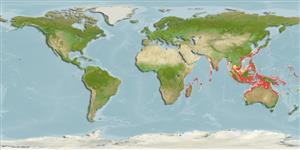分類 / Names
俗名 | 同種異名 | Catalog of Fishes(屬, 種) | ITIS | CoL | WoRMS | Cloffa
Teleostei >
Pleuronectiformes (Flatfishes)
鰈形目 (Flatfishes) >
Bothidae (Lefteye flounders)
鮃科 (Lefteye flounders)
Etymology: Crossorhombus: Greek krossoi = tassel + Greek, rhombos = paralelogram (Ref. 45335).
More on author: Alcock.
Environment: milieu / climate zone / depth range / distribution range
生態學
海洋 居於水底的; 深度上下限 13 - 60 m (Ref. 9824). 熱帶
Indo-West Pacific: Bay of Bengal, northwestern Australia, South China Sea, China, Taiwan, Japan, Viet Nam, and Aru Islands, Indonesia.
印度-西太平洋: 孟加拉灣,澳洲西北部,南中國海,中國,台灣,日本,越南與印尼的阿盧巴群島。
大小 / 重量 / 年齡
Maturity: Lm ? range ? - ? cm
Max length : 18.0 cm TL 雄魚/尚未辨別雌雄; (Ref. 9824)
背的軟條 (總數) : 84 - 92; 臀鰭軟條: 63 - 74. Ground colour on eyed side brownish grey, with darker spots and blotches. Fins paler than body, dorsal and anal fins with small dark spots, caudal fin with 2 distinct dark bands. Males with small dark spots in anterior part of interorbital region. Blind side whitish in females. Males with distinct bluish black pyriform colour pattern on blind side. Body ovoid, its depth 1.7 to 2 times in SL. Head small, snout shorter than eye, profile steep anterior to interorbital area. Head length 3.3 to 4.5 times in SL. Interorbital region broad and concave, wider in males than females in specimens greater than about 6 cm SL. Males with a rostral spine and 1 to 3 low bony bumps around orbits. Both eyes on left side of head, front margin of upper eye slightly behind front margin of lower eye. Both eyes in males larger than about 6 cm SL with a flap on posterior area. Mouth small, reaching to or slightly beyond anterior margin of lower eye, length of upper jaw 3.1 to 4.3 times in head length. Teeth in upper jaw biserial, teeth of outer row more widely spaced than teeth of inner row; teeth in lower jaw uniserial. Gill rakers short and pointed. Scales on eyed side with long ctenii. Pectoral fin on eyed side with 11 to 14 rays, its length 1.3 to 1.6 times in head length in both sexes. Pectoral fin on blind side with 9 to 12 rays (Ref 42535).
在有眼睛的一邊上的地面顏色褐灰色, 有較深色的斑點與斑塊。 鰭比身體灰白,背鰭與臀鰭有小的深色斑點, 尾鰭有 2個明顯的深色條紋。 在眼間骨區域的前部中雄性有小的深色斑點。 沒有眼睛的一邊微白色的在雌性中。 在沒有眼睛的一邊上雄性有明顯的藍黑色的梨形顏色圖案。 身體卵形體, 兩倍 SL 的它的深度 1.7。 頭部小的, 吻短於眼, 輪廓鮮明位於眼間骨區域前。 頭長 3.3 到 4.5 標準體長比率。 眼間骨區域寬的而且凹曲, 比較寬的在雄性中超過在標本的雌性大於大約 6 公分 SL。 眼窩的周圍雄性有一根嘴的棘與 1 到 3 低的多骨腫塊。 兩眼在頭部左邊, 眼睛上方眼睛下部的些微後面在前面邊緣的在前面邊緣。 在雄性的兩眼大於大約 6 cm SL 有鰓蓋在後部的區域。 嘴小的, 延伸到或略超過眼睛下部的前緣,上頜的長度 3.1 到 4.3 倍頭長。 在上頜的齒雙列的, 外部列的齒比齒更空隙大內部列; 在下頜的齒排成一列的。 鰓耙短與尖的。 鱗片有眼睛的一面具有長的櫛齒之上。 胸鰭有眼睛的一面具有 11 到 14個鰭條,它的長度之上 1.3 到 1.6 倍頭長雄性與雌性都有。 在沒有眼睛的一邊上的胸鰭 9 到 12個鰭條 (參考文獻 42535) 。
Lives on mud bottoms and feeds on bottom-living animals (Ref. 9824). Sexually dimorphic characters develop at about 6 cm SL (Ref. 9824).
生活在泥底並且吃底棲動物.(參考文獻 9824) 性別雙型性特徵發展於大約 6 公分 SL 。 (參考文獻 9824)
Life cycle and mating behavior
Maturities | 繁殖 | Spawnings | Egg(s) | Fecundities | 仔魚
印度-西太平洋: 孟加拉灣,澳洲西北部,南中國海,中國,台灣,日本,越南與印尼的阿盧巴群島。
Sainsbury, K.J., P.J. Kailola and G.G. Leyland, 1985. Continental shelf fishes of the northern and north-western Australia. An illustrated guide. CSIRO Division of Fisheries Research; Clouston & Hall and Peter Pownall Fisheries Information Service, Canberra, Australia. 375 p. (Ref. 3131)
IUCN 瀕危狀態 (Ref. 130435)
無危 (LC) ; Date assessed: 11 November 2019
人類使用
漁業: 沒有興趣
工具
特別的報告
下載 XML
網路資源
Estimates based on models
Preferred temperature (Ref.
123201): 23.6 - 28.8, mean 27.2 °C (based on 460 cells).
Phylogenetic diversity index (Ref.
82804): PD
50 = 0.5312 [Uniqueness, from 0.5 = low to 2.0 = high].
Bayesian length-weight: a=0.00912 (0.00408 - 0.02036), b=3.05 (2.87 - 3.23), in cm total length, based on LWR estimates for this (Sub)family-body shape (Ref.
93245).
營養階層 (Ref.
69278): 3.5 ±0.37 se; based on food items.
回復力 (Ref.
120179): 中等的, 族群倍增時間最少 1.4 - 4.4年 (Preliminary K or Fecundity.).
Fishing Vulnerability (Ref.
59153): Low vulnerability (10 of 100).
